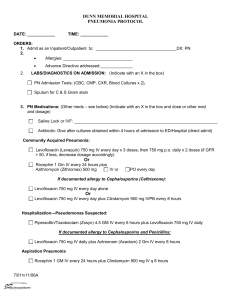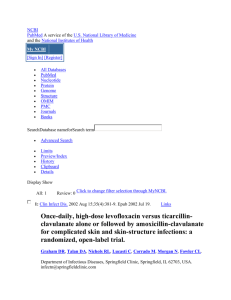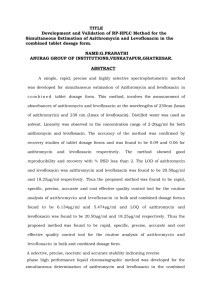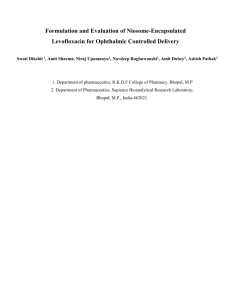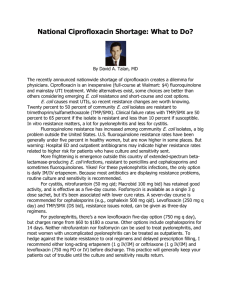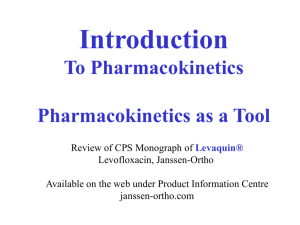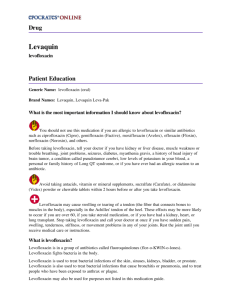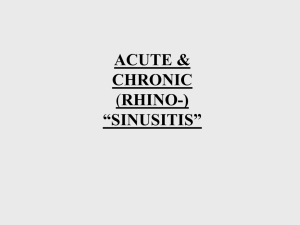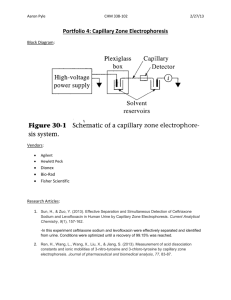Published By Science Journal Publication ISSN: 2276-7487
advertisement
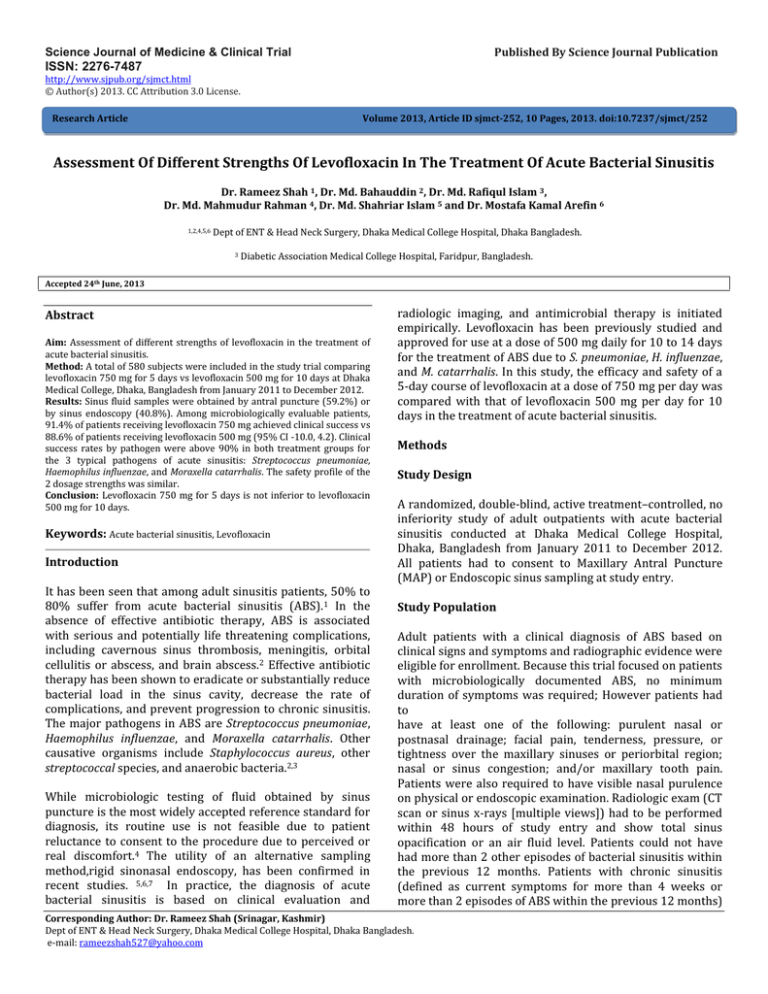
Published By Science Journal Publication Science Journal of Medicine & Clinical Trial ISSN: 2276-7487 http://www.sjpub.org/sjmct.html © Author(s) 2013. CC Attribution 3.0 License. Research Article Volume 2013, Article ID sjmct-252, 10 Pages, 2013. doi:10.7237/sjmct/252 Assessment Of Different Strengths Of Levofloxacin In The Treatment Of Acute Bacterial Sinusitis Dr. Rameez Shah 1, Dr. Md. Bahauddin 2, Dr. Md. Rafiqul Islam 3, Dr. Md. Mahmudur Rahman 4, Dr. Md. Shahriar Islam 5 and Dr. Mostafa Kamal Arefin 6 1,2,4,5,6 Dept of ENT & Head Neck Surgery, Dhaka Medical College Hospital, Dhaka Bangladesh. 3 Accepted 24th June, 2013 Diabetic Association Medical College Hospital, Faridpur, Bangladesh. Abstract Aim: Assessment of different strengths of levofloxacin in the treatment of acute bacterial sinusitis. Method: A total of 580 subjects were included in the study trial comparing levofloxacin 750 mg for 5 days vs levofloxacin 500 mg for 10 days at Dhaka Medical College, Dhaka, Bangladesh from January 2011 to December 2012. Results: Sinus fluid samples were obtained by antral puncture (59.2%) or by sinus endoscopy (40.8%). Among microbiologically evaluable patients, 91.4% of patients receiving levofloxacin 750 mg achieved clinical success vs 88.6% of patients receiving levofloxacin 500 mg (95% CI -10.0, 4.2). Clinical success rates by pathogen were above 90% in both treatment groups for the 3 typical pathogens of acute sinusitis: Streptococcus pneumoniae, Haemophilus influenzae, and Moraxella catarrhalis. The safety profile of the 2 dosage strengths was similar. Conclusion: Levofloxacin 750 mg for 5 days is not inferior to levofloxacin 500 mg for 10 days. Keywords: Acute bacterial sinusitis, Levofloxacin Introduction It has been seen that among adult sinusitis patients, 50% to 80% suffer from acute bacterial sinusitis (ABS).1 In the absence of effective antibiotic therapy, ABS is associated with serious and potentially life threatening complications, including cavernous sinus thrombosis, meningitis, orbital cellulitis or abscess, and brain abscess. 2 Effective antibiotic therapy has been shown to eradicate or substantially reduce bacterial load in the sinus cavity, decrease the rate of complications, and prevent progression to chronic sinusitis. The major pathogens in ABS are Streptococcus pneumoniae, Haemophilus influenzae, and Moraxella catarrhalis. Other causative organisms include Staphylococcus aureus, other streptococcal species, and anaerobic bacteria.2,3 While microbiologic testing of fluid obtained by sinus puncture is the most widely accepted reference standard for diagnosis, its routine use is not feasible due to patient reluctance to consent to the procedure due to perceived or real discomfort.4 The utility of an alternative sampling method,rigid sinonasal endoscopy, has been confirmed in recent studies. 5,6,7 In practice, the diagnosis of acute bacterial sinusitis is based on clinical evaluation and radiologic imaging, and antimicrobial therapy is initiated empirically. Levofloxacin has been previously studied and approved for use at a dose of 500 mg daily for 10 to 14 days for the treatment of ABS due to S. pneumoniae, H. influenzae, and M. catarrhalis. In this study, the efficacy and safety of a 5-day course of levofloxacin at a dose of 750 mg per day was compared with that of levofloxacin 500 mg per day for 10 days in the treatment of acute bacterial sinusitis. Methods Study Design A randomized, double-blind, active treatment–controlled, no inferiority study of adult outpatients with acute bacterial sinusitis conducted at Dhaka Medical College Hospital, Dhaka, Bangladesh from January 2011 to December 2012. All patients had to consent to Maxillary Antral Puncture (MAP) or Endoscopic sinus sampling at study entry. Study Population Adult patients with a clinical diagnosis of ABS based on clinical signs and symptoms and radiographic evidence were eligible for enrollment. Because this trial focused on patients with microbiologically documented ABS, no minimum duration of symptoms was required; However patients had to have at least one of the following: purulent nasal or postnasal drainage; facial pain, tenderness, pressure, or tightness over the maxillary sinuses or periorbital region; nasal or sinus congestion; and/or maxillary tooth pain. Patients were also required to have visible nasal purulence on physical or endoscopic examination. Radiologic exam (CT scan or sinus x-rays [multiple views]) had to be performed within 48 hours of study entry and show total sinus opacification or an air fluid level. Patients could not have had more than 2 other episodes of bacterial sinusitis within the previous 12 months. Patients with chronic sinusitis (defined as current symptoms for more than 4 weeks or more than 2 episodes of ABS within the previous 12 months) Corresponding Author: Dr. Rameez Shah (Srinagar, Kashmir) Dept of ENT & Head Neck Surgery, Dhaka Medical College Hospital, Dhaka Bangladesh. e-mail: rameezshah527@yahoo.com Science Journal of Medicine & Clinical Trial ISSN: 2276-7487 were excluded, as were patients with previous head or neck surgery and/or a history of serious complications of sinusitis (e.g. brain abscess or venous thrombosis). Patients who could not take oral therapy, who required hospitalization and/or surgery for their sinusitis, who were immunosuppressed, or who had cystic fibrosis were excluded. Hospitalization lasting 48 hours or more for any cause within 2 weeks prior to study entry, or within the month prior to study entry and during which antimicrobial therapy was administered, were also criteria for exclusion. Patients who had received previous systemic antimicrobial therapy within 72 hours of study entry were excluded with the exception of those who had received ≤24 hours of therapy and those who had failed a minimum of 72 hours of antimicrobial therapy with an agent other than levofloxacin or any other member of the quinolone class of antimicrobials. Study Procedures Maxillary antral puncture or endoscopically guided collection was done on all subjects at study entry. For patients in whom an endoscopic specimen was obtained, visualization of the appropriate anatomical landmarks was required and the following potential findings were to be addressed: description of amount and character of secretions, confirmation of the nature of the sample collected for culture as being appropriate, presence of hyperemia, and any anatomical abnormalities. Patients were randomized according to a computer generated randomization schedule to receive levofloxacin 750 mg daily by mouth for 5 days followed by 5 days of matched placebo or levofloxacin 500 mg daily by mouth for 10 days. Patients were evaluated at study entry, at an on-therapy visit (day 35), at a test-of-cure visit (day 17-22), and at a post study visit (day 35-45). Clinical response was evaluated at the testof-cure and post study visits. During the period between study entry and the test-of-cure visit, patients were allowed to use only acetaminophen as an analgesic and only pseudoephedrine as a decongestant. The use of nasal steroids was prohibited. Microbiology All samples obtained were sent for Gram stain and culture and susceptibility testing. Acceptable sinus specimens were required to be collected within 24 hours after study entry and to contain ≥ 25 polymorphonuclear leukocytes and ≤ 10 squamous epithelial cells per low-powered field. For organisms obtained through endoscopically guided collection and MAP, semiquantitative growth of ≥ 1 + (≥ 10 1102 colony-forming units [CFU]/mL) was required, except for S. aureus, which was required to have a semiquantitative 2 growth ≥ 2 + (≥ 102-103 CFU/mL) to be considered an acceptable specimen. Clinical and Microbiologic Efficacy The primary analysis population (microbiologically evaluable) consisted of patients with microbiologically confirmed diagnoses who were compliant with the study protocol. Clinical response was defined as cure, improvement, failure, or unable to evaluate. Cure was defined as resolution of pretreatment abnormal clinical signs and symptoms with no further antimicrobial therapy required for the infection. Improvement was defined as clinical findings subsiding significantly but with incomplete resolution of clinical evidence of infection in a patient who required no further antimicrobial therapy for sinusitis. Clinical failure was defined as no apparent response to therapy or an incomplete response requiring additional antimicrobial therapy for sinusitis. Microbiologic response was defined as eradicated, presumed eradicated, persisted, presumed persisted, or unknown. In the absence of a post therapy visit culture, a response of “presumed eradicated” was used to classify the microbiologic outcome for patients deemed clinical successes, and the term “presumed persisted” was used to classify the microbiologic outcome for patients deemed to have had clinical failure. Statistical Analyses The prospectively defined primary efficacy endpoint in this study was the clinical success rate (proportion of patients who were cured or improved) in the microbiologically evaluable population at study day 17-24. For the purpose of the statistical analysis, the test-of-cure window was expanded by 2 days to broaden the inclusion of subjects for evaluation. The secondary efficacy variables included: microbiologic response at the test-of-cure visit; microbiologic response by admission pathogen at the testof-cure visit; and clinical and microbiologic responses of patients at post study who completed therapy and were evaluated as having clinical success at the test-of-cure visit. A two-sided 95% confidence interval (CI) around the difference between treatment groups (levofloxacin 500 mg regimen minus levofloxacin 750 mg regimen) was computed.8 To conclude that a 5-day course of levofloxacin 750 mg daily was at least as efficacious as a 10-day course of levofloxacin 500 mg daily, the upper bound of the 95% CI had to be less than 15%. Descriptive statistics were used to summarize treatment-emergent adverse events and pre therapy to post therapy changes in laboratory test results and vital signs. Two-sided 95% CIs were calculated for the differences between the treatment groups in the rates of treatmentemergent adverse events overall and within each body How to Cite this Article:Dr. Rameez Shah, Dr. Md. Bahauddin, Dr. Md. Rafiqul Islam, Dr. Md. Mahmudur Rahman, Dr. Md. Shahriar Islam and Dr. Mostafa Kamal Arefin, "Assessment Of Different Strengths Of Levofloxacin In The Treatment Of Acute Bacterial Sinusitis" Science Journal of Medicine & Clinical Trials, Volume 2013, Article ID sjmct-252, 8 Pages, 2013. doi:10.7237/sjmct/252 Science Journal of Medicine & Clinical Trial ISSN: 2276-7487 system, and for the most commonly occurring treatment- emergent adverse events. 3 Table 1: Demographics (intent-to-treat population) Levofloxacin 750 (N =289) n (%) Levofloxacin 500 (N =291) n (%) Overall (N =201) n (%) 112 (39.1) 176 (60.9) 128 (44.2) 162 (55.8) 240 (41.7) 338 (58.3) 171 (59.4) 62 (21.6) 55 (19.0) 184 (63.2) 53 (18.2) 54 (18.7) 355 (61.3) 115 (19.9) 109 (18.8) Sex Male Female Age ≤45 46-64 ≥65 Smoking History Non smoker Current smoker Ex smoker Allergy History Yes No Procedure MAP Endoscopy 182 (63) 91 (31.6) 15 (5.4) 180 (61.9) 83 (28.6) 27 (9.5) 137 (47.6) 151 (52.4) 163 (56.0) 128 (44.0) 171 (59.1) 118 (40.9) 172 (59.3) 118(40.7) RESULTS Subjects in both treatment groups were comparable. Females were more than males. The majority of patients who were 45 years of age or younger and were nonsmokers. Roughly 50% of patients entered had a history of allergies. Among patients in the microbiologically evaluable population, the mean duration of symptoms was 10.3 days for patients treated with levofloxacin 750 mg daily and 11.7 days for patients treated with levofloxacin 500 mg daily with a minimum duration of symptoms of 2 days and 1 day, respectively. Although patients with a history of head and neck surgery were to be excluded, 7 patients with prior sinus surgery were included in the microbiologically evaluable population. Approximately 60% 362 (62.4) 174 (30.1) 42 (7.4) 300 (51.8) 279 (48.2) 343 (59.2) 236 (40.8) of patients had their sinus fluid sample obtained by antral puncture and 40% by endoscopy (Table 1). A total of 584 patients were randomized, of which 580 patients took at least 1 dose of study medication and were included in the intent-to-treat population. 289 patients received levofloxacin 750 mg daily for 5 days and 291 patients received levofloxacin 500 mg for 10 days. 272 and 273 patients, respectively, completed therapy in each arm (Table 2). The most common reason for premature discontinuation in both treatment arms was adverse events, whether drug-related or not, which led to discontinuation of 10 (2.6%) patients in the 750-mg group and 8 (2.0%) patients in the 500-mg group (Table 2). Table 2: Study completion/withdrawal information (intent-to-treat population) Subject disposition Total completing study medication Total unknown for discontinuation from study medication Total who withdrew from study before test-of-cure visit Total who discontinued study Levofloxacin 750 mg (N=289) n (%)a 276 (95.6) Levofloxacin 500 mg (N=291) n (%)a 277 (95.4) 16 (5.7) 16 (5.6) 1 (0.5) 11 (3.9) 1 (0.3) 13 (4.3) How to Cite this Article:Dr. Rameez Shah, Dr. Md. Bahauddin, Dr. Md. Rafiqul Islam, Dr. Md. Mahmudur Rahman, Dr. Md. Shahriar Islam and Dr. Mostafa Kamal Arefin, "Assessment Of Different Strengths Of Levofloxacin In The Treatment Of Acute Bacterial Sinusitis" Science Journal of Medicine & Clinical Trials, Volume 2013, Article ID sjmct-252, 8 Pages, 2013. doi:10.7237/sjmct/252 Science Journal of Medicine & Clinical Trial ISSN: 2276-7487 medication Reason for discontinuation from study medication Subject choice Lost to follow-up Adverse event Clinical failure Major protocol violation Resistant pathogen b Other Total who withdrew from study between last dose and test-of-cure visit Total who completed study through test-of-cure visit Total eligible for poststudy visit evaluationc Completed poststudy visit 4 0 (0.0) 0 (0.0) 7 (2.6) 1 (0.3) 2 (0.8) 0 (0.0) 1 (0.3) 5 (1.8) 0 (0.0) 2 (0.8) 4 (1.8) 271 (93.8) 274 (94.1) 239 (82.8) 252 (86.7) 247 (85.6) Percentages based on total number of subjects with continuation/withdrawal information. Suspected, confirmed, or reported resistant pathogen (associated with evidence of ineffective treatment). cIncludes all subjects who completed therapy and were cured or improved at the test-of-cure visit. a b 1 (0.3) 0 (0.0) 5 (2.0) 3 (1.0) 1 (0.3) Among microbiologically evaluable patients at the test ofcure visit, clinical success occurred among 91.4% of patients treated with levofloxacin 750 mg daily for 5 days. In patients treated with 500 mg levofloxacin for 10 days, clinical success occurred in 88.6% (95% CI -10.0, 4.2), thereby satisfying the protocol-specified criterion of no inferiority for the 750-mg regimen. Failure occurred in 8.6% and 11.4% of each group, respectively (Table 3). Among patients receiving levofloxacin 750 mg assessed as having achieved clinical success, 44.7% were cured and 46.7% were improved. Among patients receiving levofloxacin 500 mg, 53.0% were cured and 35.6% were improved. For patients receiving levofloxacin 750 mg, results were similar regardless of sinus fluid sampling method. However, among patients receiving levofloxacin 500 mg, patients whose sinus fluid was sampled by antral puncture had a better outcome than those who underwent endoscopy (Table 4). Clinical response against the common pathogens associated with sinusitis (S. pneumoniae, H. influenzae, and M. catarrhalis) was high (>90% for all 3 pathogens) in both groups. Approximately 75% of patients infected with S. aureus in both treatment groups were either cured or improved (Table 5). Microbiologic response by pathogen at test-of-cure was above 90% in both arms for the common pathogens associated with acute sinusitis. Though not statistically significant, the eradication rate for S. aureus was higher among patients treated with levofloxacin 500 mg than among patients treated with levofloxacin 750 mg (83.3% vs 76.0%, respectively) (Table 6). Overall 257 (88.5) susceptibility to levofloxacin among all pathogens isolated was 98.9%. Long-term clinical success and microbiologic eradication outcomes at post study were similar between the 2 treatment groups. Among patients who were treated with levofloxacin 750 mg, 94.1% were classified as having longterm clinical cure or improvement vs 93.1% of patients receiving levofloxacin 500 mg. With regard to microbiologic eradication, 94.1% of patients treated with levofloxacin 750 mg were classified as having long-term eradication/presumed eradication while 94.6% receiving levofloxacin 500 mg were so classified (Table 7). Two patients in the 500-mg treatment arm were deemed clinical failures but demonstrated continued eradication of the admission pathogen through the post study visit based on repeat sampling. Long-term clinical relapse rates were also similar between the 2 treatment groups (5.9% vs 6.9%, respectively). Among patients who took at least 1 dose of study medication and provided on-therapy safety information (safetyevaluable population), the safety profile of the 2 dosage strengths was similar. Overall, 39.8% of patients receiving levofloxacin 750 mg and 34.5% of patients receiving levofloxacin 500 mg experienced an adverse event. Incidence of treatment-emergent adverse events (occurring during treatment or up to study day 24) reported by ≥ 2.0% of patients by body system was also similar between the 2 groups (Table 8). Table 3:Clinical success/nonsuccess at test-of-cure by sample collection method and pathogen of primary interest (microbiologically evaluable population) How to Cite this Article:Dr. Rameez Shah, Dr. Md. Bahauddin, Dr. Md. Rafiqul Islam, Dr. Md. Mahmudur Rahman, Dr. Md. Shahriar Islam and Dr. Mostafa Kamal Arefin, "Assessment Of Different Strengths Of Levofloxacin In The Treatment Of Acute Bacterial Sinusitis" Science Journal of Medicine & Clinical Trials, Volume 2013, Article ID sjmct-252, 8 Pages, 2013. doi:10.7237/sjmct/252 Science Journal of Medicine & Clinical Trial ISSN: 2276-7487 Sample collection method MAP Enterobacter aerogenes Haemophilus influenzae Haemophilus parainfluenzae Moraxella catarrhalis Proteus mirabilis Pseudomonas aeruginosa Staphylococcus aureus Streptococcus pneumoniae Streptococcus pyogenes Endoscopy Enterobacter aerogenes Haemophilus influenzae Haemophilus parainfluenzae Moraxella catarrhalis Proteus mirabilis Pseudomonas aeruginosa Staphylococcus aureus Streptococcus pneumoniae Streptococcus pyogenes Total 5 Levofloxacin750mg Successa Nonsuccessb n/N (%) n/N (%) Levofloxacin 500 mg Success Nonsuccess n/N (%) n/N (%) 1/1 (100.0)0/1 (0.0) 19/21(90.5)2/21 (9.5) 9/9 (100.0) 0/9 (0.0) 10/11(90.9)1/11 (9.1) 0 (0.0) 0 (0.0) 2/3 (66.7)1/3 (33.3) 9/12(75.0)3/12 (25.0) 25/27(92.6)2/27 (7.4) 3/3 (100.0) 0/3 (0.0) 1/2(50.0) 1/2 (50.0) 25/27(92.6)2/27 (7.4) 10/11(90.9)1/11 (9.1) 13/13(100.0)0/13(0.0) 2/2 (100.0) 0 (0.0) 5/7(71.4) 2/7 (28.6) 3/3 (100.0) 0/3 (0.0) 26/27(96.3)1/27 (3.7) 2/2 (100.0) 0 (0.0) 81/90(90.0)9/90 (10.0) 89/95 (93.7) 58/62(93.5)4/62 (6.5) 6/95 (6.3) 139/152(91.4)13/152(8.6) 3.7 (_4.8, 12.1) 43/54(79.6)11/54 (20.4) _13.9 (_27.2, _0.6) 132/149(88.6)17/149(11.4) _2.9 (_10.0, 4.2) 1/2(50.0)1/2 (50.0) 13/14(92.9)1/14 (7.1) 1/1(100.0) 0/1 (0.0) 5/6 (83.3)1/6 (16.7) 2/3 (66.7)1/3 (33.3) 2/2 (100.0) 0 (0.0) 6/9 (66.7)3/9 (33.3) 14/17(82.4)3/17(17.6) 3/3(100.0) 0/3 (0.0) 4/4(100.0) 0/4 (0.0) 16/16(100.0)0/16(0.0) 1/1(100.0) 0/1 (0.0) 6/6(100.0) 0/6 (0.0) 2/2 (100.0) 0/2 (0.0) 3/4 (75.0)1/4 (25.0) 10/13(76.9)3/13(23.1) 17/18 (94.4)1/18 (5.6) 2/2 (100.0) 0/2 (0.0) Difference c (95% CI)d Note: N for pathogen of primary interest is the number of subjects who had the pathogen alone or in combination with other pathogens at study entry. a Success rates include the clinical response categories of cured and improved. b Nonsuccess rates include the clinical response category of failure. c Difference in success rates (levofloxacin 500 mg minus levofloxacin 750 mg). d Two-sided 95% confidence intervals (with continuity correction) were calculated around the difference (comparator minus levofloxacin 750 mg daily by mouth 5-day regimen) in clinical success rates (cured and improved). DISCUSSION In this study focus was on patients with microbiologically documented ABS rather than all of the patients. The 500-mg dosage regimen had been previously approved for use in treating this infection. Clinical success was similar in the 2 treatment groups, indicating that the higher dose of levofloxacin administered for a shorter period is as effective as the lower dose administered for a longer period. Adverse events were also similar between the 2 treatment groups, as has been observed in previous studies comparing the 2 dosages. There are several potential advantages associated with high dose, short-course therapy with fluoroquinolone antimicrobials such as levofloxacin. The kill rates of these agents are concentration= dependent. Because of this, therapeutic outcome is linked to area under the concentration curve (AUC) rather than to time above the minimum inhibitory concentration (MIC).9 Table 4: Clinical outcomes at test-of-cure (microbiologically evaluable population) Sample collection method MAP Endo Total Levofloxacin 750 Cured Improved n/N (%) n/N (%) 41/90 (45.6) 40/90 (44.4) 27/62 (43.5) 31/62 (50.0) Failure n/N(%) 9/90 (10.0) 4/62 (6.5) 68/152 (44.7) 71/152 (46.7) 13/152(8.6) Higher doses may result in more rapid resolution of symptoms and shorter-course therapy may improve patient compliance and decrease the incidence of adverse events. The most compelling reason, however, is reducing exposure to the drug in order to help prevent the development of resistance. High peak concentration has been linked to prevention of the emergence of resistance.10,11 Shortercourse regimens also have implications for preventing the emergence of resistance. It is now generally accepted that Levofloxacin 500 Cured Improved n/N (%) n/N (%) 53/95 (55.8) 36/95 (37.9) 26/54 (48.1) 17/54 (31.5) Failure n/N (%) 6/95 (6.3) 11/54 (20.4) 79/149(53.0) 53/149(35.6) 17/149 (11.4) the development of resistance is most closely associated with the amount of drug to which the patient is exposed. 10 Shorter-course therapies reduce total drug exposure over the course of treatment. In this study, both MAP and endoscopy as techniques were utilized for sampling sinus fluid. Previous studies, in which samples for microbiologic evaluation have been collected by both antral puncture and endoscopy, confirmed the utility of How to Cite this Article:Dr. Rameez Shah, Dr. Md. Bahauddin, Dr. Md. Rafiqul Islam, Dr. Md. Mahmudur Rahman, Dr. Md. Shahriar Islam and Dr. Mostafa Kamal Arefin, "Assessment Of Different Strengths Of Levofloxacin In The Treatment Of Acute Bacterial Sinusitis" Science Journal of Medicine & Clinical Trials, Volume 2013, Article ID sjmct-252, 8 Pages, 2013. doi:10.7237/sjmct/252 Science Journal of Medicine & Clinical Trial ISSN: 2276-7487 endoscopic cultures for the major pathogens involved in acute bacterial maxillary sinusitis. 6 Table 5: Clinical response rates at test-of-cure visit by pathogen of primary interesta (microbiologically evaluable population) Pathogen of interesta Enterobacter aerogenes Haemophilus influenzae Haemophilus parainfluenzae Moraxella catarrhalis Proteus mirabilis Pseudomonas aeruginosa Staphylococcus aureus Streptococcus pneumoniae Streptococcus pyogenes Levofloxacin 750 Cured Improved Nb n/N (%) 5 2(40.0) 37 21(56.8) 10 4(40.0) 17 2 7 25 45 5 7(41.2) 1(50.0) 4(57.1) 10(40.0) 20(44.4) 2(40.0) n/N (%) 3(60.0) 14(37.8) 6(60.0) 9(52.9) 1(50.0) 1(14.3) 9(36.0) 22(48.9) 3(60.0) Failure n/N (%) 0(0) 2(5.4) 0(0) 1(5.9) 0(0) 2(28.6) 6(24.0) 3(6.7) Note: Percentages are percentages of N for the pathogen and treatment group. a N ≥ 5 in either treatment group. b N = number of patients who had the pathogen alone or in combination with other pathogens at admission. In a study of 13 patients, endoscopically guided meatal culture identified the predominant bacterial pathogen and correlated with the cultures from maxillary sinus aspiration in over 90% of infections.5 In another study evaluating 46 patients, the accuracy of endoscopy was 89.1% with respect 0(0) Levofloxacin 500 Cured Improved N n/N (%) 4 1(25.0) 41 23(56.1) 12 7(58.3) 19 5 9 12 44 5 12(63.2) 4(80.0) 3(33.3) 4(33.3) 22(50.0) 1(20.0) n/N (%) Failure n/N (%) 1(25.0) 2(50.0) 15(36.6) 3(7.3) 4(33.3) 1(8.3) 6(31.6) 0(0) 4(44.4) 5(41.7) 18(40.9) 4(80.0) 1(5.3) 1(20.0) 2(22.2) 3(25.0) 4(9.1) 0(0) to recovery of the 3 major pathogens of ABS.6 An additional study of 24 patients in a single center demonstrated an accuracy of 88.5% for endoscopy. 7 Further, prospective studies with a larger sample size have been advocated in order to further validate the technique.4 Table 6: Microbiologic eradication at test-of-cure by pathogen of interest (microbiologically evaluable population) Pathogen of interesta Enterobacter aerogenes Haemophilus influenzae Haemophilus parainfluenzae Moraxella catarrhalis Proteus mirabilis Pseudomonas aeruginosa Staphylococcus aureus Streptococcus pneumoniae Streptococcus pyogenes Levofloxacin 750 Eradicatedb n/N (%) 5/5 (100) 35/37 (94.6) 10/10 (100.0) 16/17 (94.1) 2/2 (100.0) 5/7 (71.4) 19/25 (76.0) 43/45 (95.6) 5/5 (100.0) Levofloxacin 500 Eradicated n/N (%) 2/4 (50.0) 38/41 (92.7) 11/12 (91.7) 18/19 (94.7) 4/5 (80.0) 7/9 (77.8) 10/12 (83.3) 40/44 (90.9) 5/5 (100.0) N ≥ 5 in either treatment group. Eradicated includes presumed eradicated. Difference in eradication rates (levofloxacin 500 mg minus levofloxacin 750 mg). d Two-sided 95% confidence intervals (with continuity correction) around the difference in microbiologic eradication rates for pathogens identified in 10 or more patients in each treatment group. a b c Differencec 95% CI)d _50.0 _1.9 (_14.1, 10.2) _8.3 (_29.0, 12.3) 0.6 (_17.4, 18.6) _20.0 6.3 7.3 (_23.8, 38.4) _4.6 (_16.2, 6.9) 0 Table 7: Microbiologic outcomes at post study (microbiologically evaluable population) Levofloxacin 750 (N=135)b Levofloxacin 500 (N=130) Eradicated/presumed eradicated n (%) 127 (94.1) 123 (94.6) Note: All microbiologic response rates are by patient. Includes new infection. a Relapsed/presumed relapseda n (%) 8 (5.9) 7 (5.4) Unknown n (%) 0 (0) 0 (0) How to Cite this Article:Dr. Rameez Shah, Dr. Md. Bahauddin, Dr. Md. Rafiqul Islam, Dr. Md. Mahmudur Rahman, Dr. Md. Shahriar Islam and Dr. Mostafa Kamal Arefin, "Assessment Of Different Strengths Of Levofloxacin In The Treatment Of Acute Bacterial Sinusitis" Science Journal of Medicine & Clinical Trials, Volume 2013, Article ID sjmct-252, 8 Pages, 2013. doi:10.7237/sjmct/252 Science Journal of Medicine & Clinical Trial ISSN: 2276-7487 b 7 Includes only patients cured or improved at the test-of-cure visit who returned for the post study visit. There were some additional findings of interest among these data relating to sampling method. Among microbiologically evaluable patients whose samples were obtained by endoscopy, a much better clinical success rate was observed among patients treated with levofloxacin 750 mg than those treated with 500 mg. In this study no clinical criteria were used to assign patients to antral puncture or endoscopy. Success rates for the 2 treatment groups in patients undergoing antral puncture were comparable, indicating that drug dosage alone was not a factor. Antral puncture removes a much larger volume of sinus fluid than does endoscopy and may have a therapeutic effect in and of itself. The absence of therapeutic drainage combined with a lower dose of antibiotic may account for the less successful outcome in patients receiving levofloxacin 500 mg who underwent endoscopy. As there were similar results in patients receiving levofloxacin 750 mg who underwent either antral puncture or endoscopy, it may be that the higher dose of levofloxacin overcame the impact of not draining the sinus cavity. Table 8: Incidence of frequently reported (≥2.0%) treatment-emergent adverse events summarized by body system and preferred term (safety-evaluable population) Body system preferred terma Central & peripheral nervous system disorders Dizziness Headache Gastrointestinal system disorders Abdominal pain Diarrhea Dyspepsia Mouth dry Nauseac Vomitingd Psychiatric disorders Insomnia Resistance mechanism disorders Moniliasis genital Secondary terms Procedural site reaction Total patients with adverse events Levofloxacin 750 mg (N =289) n (%) Levofloxacin 500 mg (N =291) n (%) 95% CIb 9 (3.1) 13 (4.6) 4 (1.3) 9 (3.1) (-4.0, 0.4) (-4.4, 1.3) 3 (1.1) 15 (5.1) 6 (2.1) 7 (2.6) 24 (8.2) 10 (3.6) 9 (2.6) 14 (4.9) 6 (2.0) 4 (1.5) 12 (4.3) 4 (1.3) (-0.5, 3.5) (-3.5, 2.9) (-2.1, 2.1) (-3.2, 1.1) (-7.4, _0.4) (-4.6, 0.0) 2 (0.8) 7 (2.6) (-0.1, 3.7) 8 (2.8) 4 (1.5) 115 (39.8) 7 (2.6) 6 (2.0) 100 (34.5) Note: Table includes treatment-emergent adverse events, i.e., those that began on-therapy or up to study day 24, whether related to treatment or not. a Preferred term reported by -2.0% of patients in either treatment group. Two-sided 95% confidence interval (with continuity correction) around the difference between treatments (levofloxacin 500 mg minus levofloxacin 750 mg) in incidence of adverse events. c The difference in drug-related nausea, i.e., nausea for which the investigator determined that the event was definitely or probably related to treatment, was not statistically significant, occurring in 3.3% of patients receiving levofloxacin 750 mg vs 2.8% of patients receiving levofloxacin 500 mg (95% CI – 1.6, 2.6). d The difference in drug-related vomiting, i.e., vomiting for which the investigator determined that the event was definitely or probably related to treatment, was not statistically significant, occurring in 1.0% of patients receiving levofloxacin 750 mg vs 0.8% of patients receiving levofloxacin 500 mg (95% CI _1.7, 1.2). b It was found that S. aureus continued to be a common pathogen in community-acquired ABS. In the microbiologically evaluable population in the study, roughly 12% of patients presented with S. aureus as the causative pathogen of their ABS. Patients with symptoms for more than 28 days or with more than 2 other episodes of ABS (-2.7, 2.1) (-1.5, 2.5) (-12.2, 1.6) within 12 months prior to study entry were purposely excluded from participation in the study. By doing so, patients with chronic sinusitis were excluded. Also, patients with a history of previous head or neck surgery, which, in the case of those with previous sinus surgery, might alter bacterial etiology, were excluded. Patients who had been How to Cite this Article:Dr. Rameez Shah, Dr. Md. Bahauddin, Dr. Md. Rafiqul Islam, Dr. Md. Mahmudur Rahman, Dr. Md. Shahriar Islam and Dr. Mostafa Kamal Arefin, "Assessment Of Different Strengths Of Levofloxacin In The Treatment Of Acute Bacterial Sinusitis" Science Journal of Medicine & Clinical Trials, Volume 2013, Article ID sjmct-252, 8 Pages, 2013. doi:10.7237/sjmct/252 Science Journal of Medicine & Clinical Trial ISSN: 2276-7487 recently hospitalized were also excluded, decreasing the chances that their infection was nosocomial in origin. It is also interesting to note that the efficacy of the 500-mg dosage regimen seems little changed over the last several years. The original studies in ABS with the 500-mg dosage form were conducted in the mid-1990s. Two studies were conducted, one comparative against amoxicillin/clavulanate and the other was non comparative. In these trials, the efficacy of levofloxacin in this infection was 88.4% and 88%, respectively.12,13 These compared well with the efficacy of 88.6% for the 500-mg dosage regimen shown in the study at hand. There were several potential sources of bias in this study. Two dosage levels of levofloxacin were studied and compared to one another. It is possible that, if compared against another active control, one would have obtained a different result. However, at least 1 previous study of the 500-mg dosage level was performed against an active control. Two different methodologies were utilized for obtaining of sinus fluid samples. The results might have differed if one had made use of only 1 of the 2 techniques to obtain all of the samples. However the outcome of the 2 sampling methods were reported separately. Clinical criteria were not imposed for the use of antral puncture or endoscopy. It is possible that, if one had imposed criteria (e.g., severity criteria) for the use of one or the other methodology, one would have obtained different results. While this trial followed accepted design for study of antimicrobials in acute sinusitis, concerns over this study design itself have been raised. Specifically, the time point for the test-of-cure visit occurred relatively late in the disease course. Previous data indicate that acute bacterial sinusitis may have a high rate of spontaneous resolution, leading some to suggest that different time points should be selected for evaluation of antimicrobial efficacy.14 However; the present study was not designed to address this issue. In conclusion, levofloxacin 750 mg administered as a 5-day treatment course was as effective as levofloxacin 500 mg administered as a 10-day treatment course. Given the advantages inherent in a high-dose, short-course treatment strategy, including the diminished risk of driving resistance, it is believed that levofloxacin 750 mg for 5 days is an effective and safe regimen for the treatment of ABS. REFERENCE 1. 2. 3. 4. 5. 6. 7. 8. 9. 8 Lau JL, Zucker D, Engels EA, et al. Diagnosis and treatment of acute bacterial rhinosinusitis. Evid Rep Technol Assess (Summ) 1999;9:1–5. (Grade A). Gwaltney JM. Acute community-acquired sinusitis. Clin Infect Dis 1996;23:1209 –25. (Grade B). Brook I, Gooch WM, Jenkins SG, et al. Medical management of acute bacterial sinusitis. Recommendations of a clinical advisory committee on pediatric and adult sinusitis. Ann Otol Rhinol Laryngol Suppl 2000;182:2–20. (Grade B). Benninger MS, Appelbaum PC, Denneny JC, et al. Maxillary sinus puncture and culture in the diagnosis of acute rhinosinusitis: the case for pursuing alternative culture methods. Otolaryngol Head Neck Surg 2002;127:7–12. (Grade B). Vogan JC, Bolger WE, Keyes AS. Endoscopically guided sinonasal cultures: a direct comparison with maxillary sinus aspirate cultures. Otolaryngol Head Neck Surg 2000;122:370 –3. (Grade B). Talbot GH, Kennedy DW, Scheld M, et al. Rigid nasal endoscopy versus sinus puncture and aspiration for microbiologic documentation of acute bacterial maxillary sinusitis. Clin Infect Dis 2001;33:1668–75. (Grade B). Joniau S, Vlaminck S, Van Landuyt H, et al. Microbiology of sinus puncture versus middle meatal aspiration in acute bacterial maxillary sinusitis. Am J Rhinol 2005;19:135– 40. (Grade B). Hauck W, Anderson S. A comparison of large sample confidence interval methods for the difference of two binomial probabilities. Am Stat 1986;40:318 –22. Forrest A, Nix DE, Ballow CH, et al. Pharmacodynamics of intravenous ciprofloxacin in seriously ill patients. Antimicrob Agents Chemother 1993;37:1073– 81. (Grade A). 10. Drusano GL, Johnson DE, Rosen M, et al. Pharmacodynamics of a fluoroquinolone antimicrobial agent in a neutropenic rat model of Pseudomonas sepsis. Antimicrob Agents Chemother 1993;37:483–90 11. Jumbe N, Louie A, Leary R, et al. Application of a mathematical model to prevent in vivo amplification of antibiotic-resistant bacterial populations during therapy. J Clin Invest 2003;112:275– 85. 12. Adelglass J, DeAbate A, McElvaine P, et al. Comparison of the effectiveness of levofloxacin and amoxicillin-clavulanate for the treatment of acute sinusitis in adults. Otolaryngol Head Neck Surg 1999; 120:320 –7. (Grade A). 13. Sydnor TA, Kopp EJ, Anthony KE, et al. Open-label assessment of levofloxacin for the treatment of acute bacterial sinusitis in adults. AnnAllergy Asthma Immunol 1998;80:357– 62. (Grade B). 14. Marple BF. Dilemma in trial design: do current study designs adequately evaluate effectiveness antibiotic [sic] in ABRS. Otolaryngol Head Neck Surg 2005;133:200 –1. (Grade D). How to Cite this Article:Dr. Rameez Shah, Dr. Md. Bahauddin, Dr. Md. Rafiqul Islam, Dr. Md. Mahmudur Rahman, Dr. Md. Shahriar Islam and Dr. Mostafa Kamal Arefin, "Assessment Of Different Strengths Of Levofloxacin In The Treatment Of Acute Bacterial Sinusitis" Science Journal of Medicine & Clinical Trials, Volume 2013, Article ID sjmct-252, 8 Pages, 2013. doi:10.7237/sjmct/252
